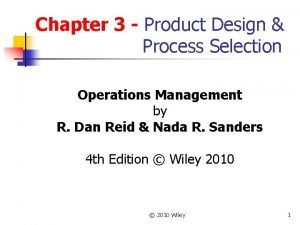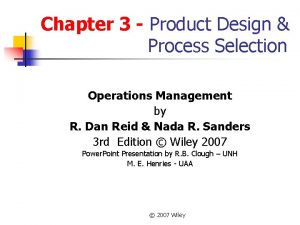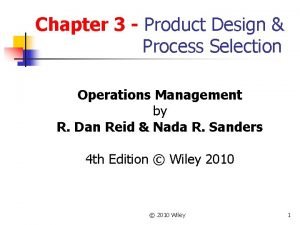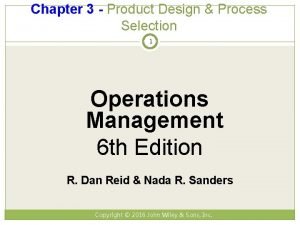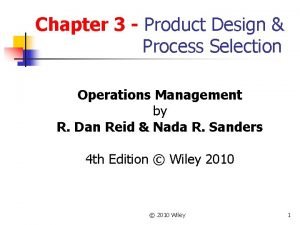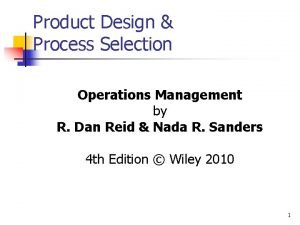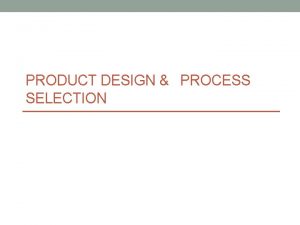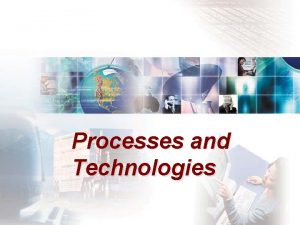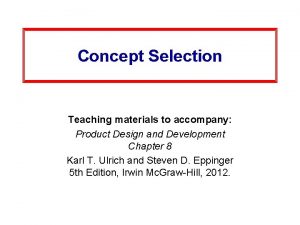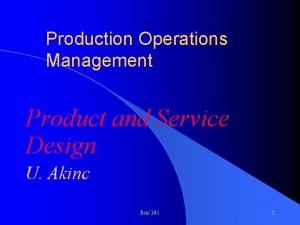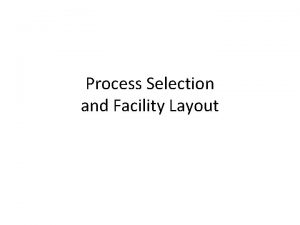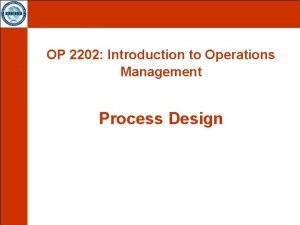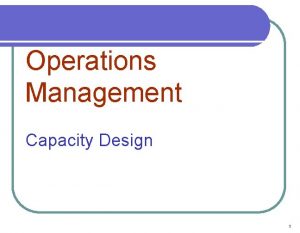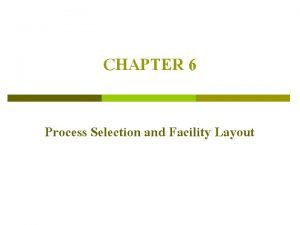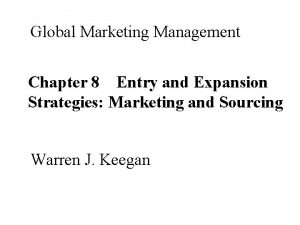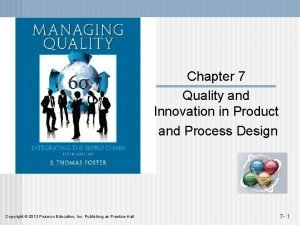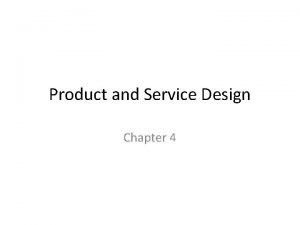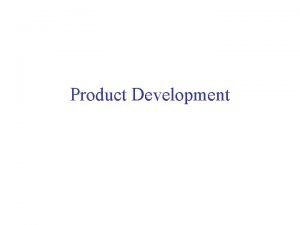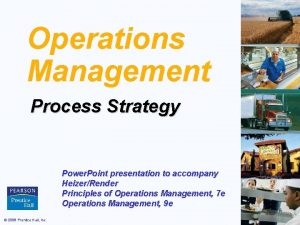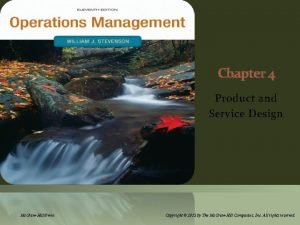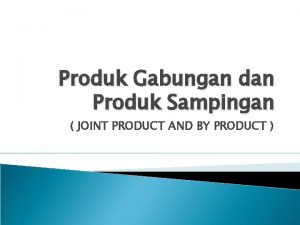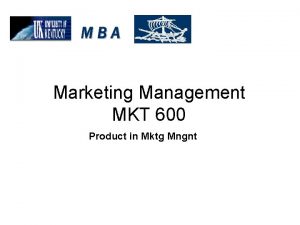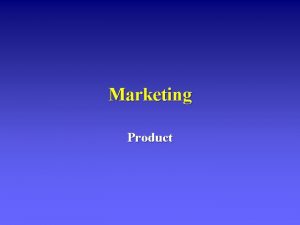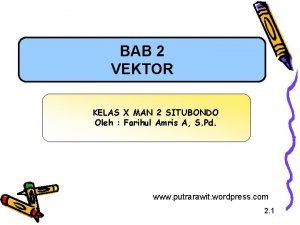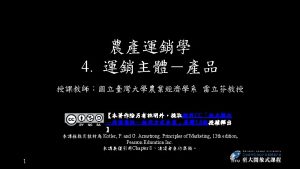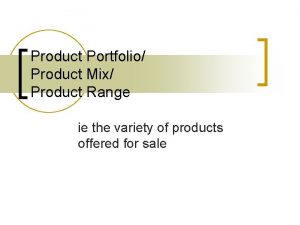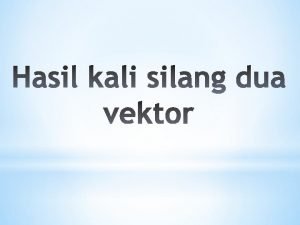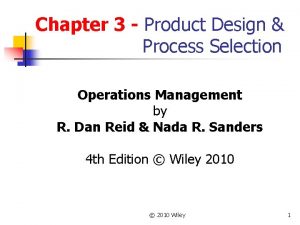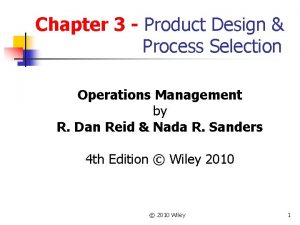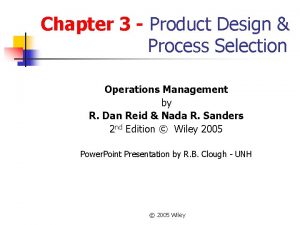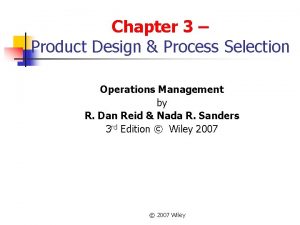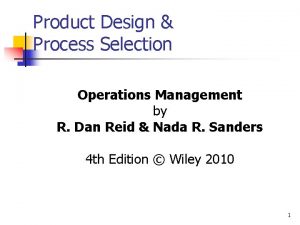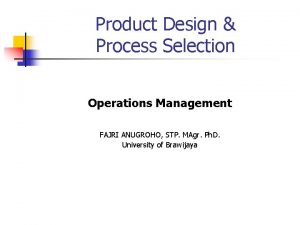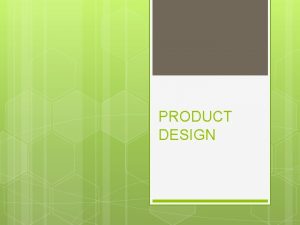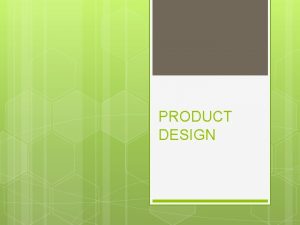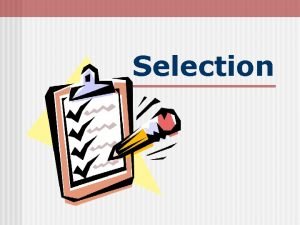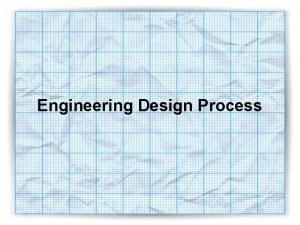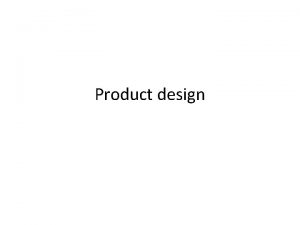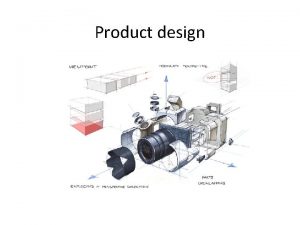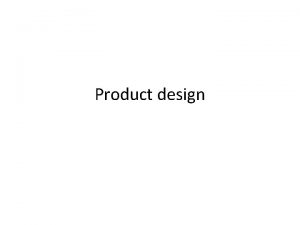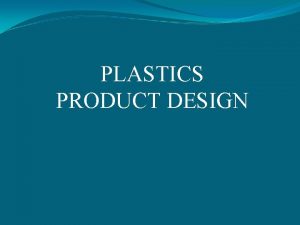Chapter 3 Product Design Process Selection 1 Operations














































- Slides: 46

Chapter 3 - Product Design & Process Selection 1 Operations Management 6 th Edition R. Dan Reid & Nada R. Sanders Copyright © 2016 John Wiley & Sons, Inc.

Learning Objectives 2 �Define product design and explain its strategic impact on organizations �Describe steps to develop a product design �Use break-even analysis as a tool in deciding between alternative products �Identify different types of processes and explain their characteristics Copyright © 2016 John Wiley & Sons, Inc.

Learning Objectives – cont’d 3 �Understand how to use a process flowchart �Understand how to use process performance metrics �Understand the link between product design and process selection �Understand current technological advancements and how they impact process and product design �Understand issues of designing service operations Copyright © 2016 John Wiley & Sons, Inc.

Product Design & Process Selection 4 �Product Design – the process of defining all of the company’s product characteristics Product design must support product manufacturability (the ease with which a product can be made) Product design defines a product’s characteristics of: • appearance, materials, dimensions, tolerances, and performance standards �Process Selection – the development of the process necessary to produce the designed product. Copyright © 2016 John Wiley & Sons, Inc.

Design of Services versus Goods 5 �Service design is unique in that both the service and the entire service concept are being designed Must define both the service and concept � Physical elements, aesthetic & psychological benefits e. g. promptness, friendliness, ambiance Product and service design must match the needs and preferences of the targeted customer group Copyright © 2016 John Wiley & Sons, Inc.

The Product Design Process 6 �Idea development: all products begin with an idea whether from: customers, competitors or suppliers �Benchmarking: studying “best-in-class” companies and comparing to your company’s performance �Reverse engineering: process of disassembling a product to analyze its design features �Early supplier involvement: involving suppliers in the early stages of product design. Copyright © 2016 John Wiley & Sons, Inc.

Product Design Process 7 Copyright © 2016 John Wiley & Sons, Inc.

The Product Design Process 8 Step 1 - Idea Development - Someone thinks of a need and a product/service design to satisfy it: customers, marketing, engineering, competitors, benchmarking, reverse engineering Step 2 - Product Screening - Every business needs a formal/structured evaluation process: fit with facility and labor skills, size of market, contribution margin, break-even analysis, return on sales Step 3 – Preliminary Design and Testing - Technical specifications are developed, prototypes built, testing starts Step 4 – Final Design - based on test results, facility, equipment, material, & labor skills defined, suppliers identified Copyright © 2016 John Wiley & Sons, Inc.

Product Screening Tool – Break-Even Analysis 9 �Computes the quantity of goods company needs to sell to cover its costs QBE = F/ (SP - VC) QBE – Break even quantity F – Fixed costs SP – selling price/unit VC – Variable cost Copyright © 2016 John Wiley & Sons, Inc.

Product Screening Tool – Break-Even Analysis 10 Break-even analysis also includes calculating (Q = number of units sold) Total cost – sum of fixed and variable cost Total cost = F + (VC)*Q Revenue – amount of money brought in from sales Revenue = (SP) * Q Copyright © 2016 John Wiley & Sons, Inc.

Break-Even Analysis: Graphical Approach 11 � Compute quantity of goods that must be sold to breakeven � Compute total revenue at an assumed selling price � Compute fixed cost and variable cost for several quantities � Plot the total revenue line and the total cost line � Intersection is break-even Copyright © 2016 John Wiley & Sons, Inc.

Break-Even Example: 12 A company is planning to establish a chain of movie theaters. It estimates that each new theater will cost approximately $1 Million. The theaters will hold 500 people and will have 4 showings each day with average ticket prices at $8. They estimate that concession sales will average $2 per patron. The variable costs in labor and material are estimated to be $6 per patron. They will be open 300 days each year. What must average occupancy be to break-even? Copyright © 2016 John Wiley & Sons, Inc.

Break-Even Example Calculations 13 � Break-Even Point Total revenues = Total costs @ break-even point Q Selling price*Q = Fixed cost + variable cost*Q ($8+$2)Q= $1, 000 + $6*Q Q = 250, 000 patrons (42% occupancy) � What is the gross profit if they sell 300, 000 tickets Profit = Total Revenue – Total Costs P = $10*300, 000 – (1, 000 + $6*300, 000) P = $200, 000 � If concessions only average $. 50/patron, what is break-even Q now? (sensitivity analysis) ($8. 50)Q = 1, 000 - $6*Q Q = 400, 000 patrons (67% occupancy) Copyright © 2016 John Wiley & Sons, Inc.

Factors Impacting Product Design � Design for Manufacturing – DFM 14 � Guidelines to produce a product easily and profitably Simplification - Minimize parts Standardization � Design parts for multiply applications Use modular design Less or avoid tools Simplify operations Copyright © 2016 John Wiley & Sons, Inc.

Factors In Product Life Cycle 15 � Product life cycle – series of changing product demand � Consider product life cycle stages Introduction, Growth, Maturity, Decline � Facility & process investment depends on life cycle Copyright © 2016 John Wiley & Sons, Inc.

Concurrent Engineering 16 Old “over-the-wall” sequential design process should not be used � Each function did its work and passed it to the next function Replace with a Concurrent Engineering process � All functions form a design team that develops specifications, involves customers early, solves potential problems, reduces costs, & shortens time to market Copyright © 2016 John Wiley & Sons, Inc.

Concurrent Engineering 17 Copyright © 2016 John Wiley & Sons, Inc.

Remanufacturing 18 Uses components of old products in the production of new ones and has: Environmental benefits Cost benefits Good for: Computers, televisions, automobiles Copyright © 2016 John Wiley & Sons, Inc.

Types of Processes 19 �Intermittent operations: Processes used to produce a variety of products with different processing requirements in lower volumes. (such as healthcare facility) �Repetitive operations: Processes used to produce one or a few standardized products in high volume. (such as a cafeteria, or car wash) Copyright © 2016 John Wiley & Sons, Inc.

Process Selection 20 Product design considerations must include the process � Differences between Intermittent & Repetitive Ops: � (1) (2) the amount of product volume produced, and the degree of product standardization. Copyright © 2016 John Wiley & Sons, Inc.

Copyright © 2016 John Wiley & Sons, Inc.

Process Types 22 �Process types can be: Project process – make a one-at-a-time product exactly to customer specifications Batch process – small quantities of product in groups or batches based on customer orders or specifications Line process – large quantities of a standard product Continuous process – very high volumes of a fully standard product �Process types exist on a continuum Copyright © 2016 John Wiley & Sons, Inc.

Underlying Process Relationship Between Volume and Standardization Continuum Copyright © 2016 John Wiley & Sons, Inc.

Process Selection Considerations 24 � Process selection is based on five considerations 1. 2. 3. 4. 5. Type of process; range from intermittent to repetitive or continuous Degree of vertical integration Flexibility of resources Mix between capital & human resources Degree of customer contact Copyright © 2016 John Wiley & Sons, Inc.

Process Design Tools 25 Often stages in the production process can be performed in parallel, as shown here in (c) and (d). The two stages can produce different products (c) or the same product (d). Copyright © 2016 John Wiley & Sons, Inc.

Designing Processes 26 �Process design tools include: Process flow analysis Process flowchart �Design considerations include: Make-to-stock strategy Assemble-to-order strategy Make-to-order strategy See flowcharts for different product strategies at Antonio’s Pizzeria (next slide) Copyright © 2016 John Wiley & Sons, Inc.

Copyright © 2016 John Wiley & Sons, Inc.

Process Flowchart of Customer Flow at Antonio’s Pizzeria 28 A basic process performance metric is throughput time. A lower throughput time means that more products can move through the system. One goal of process improvement is to reduce throughput time. Copyright © 2016 John Wiley & Sons, Inc.

Process Performance Metrics 29 �Definition: Measurement of different process characteristics that tell us how a process is performing Determining if a process is functioning properly is required Determination requires measuring performance Copyright © 2016 John Wiley & Sons, Inc.

Process Performance Metrics 30 Copyright © 2016 John Wiley & Sons, Inc.

Linking Product Design & Process Selection 31 �Product design and process selection are directly linked �Type of product selected defines type of operation required �Type of operation available defines broader organizational aspects such as Equipment required Facility arrangement Organizational structure Copyright © 2016 John Wiley & Sons, Inc.

Linking Design and Process Selection 32 Organizational Decisions appropriate for different types of operations Copyright © 2016 John Wiley & Sons, Inc.

Linking Product Design & Process Selection 33 �Product Design Decisions: Intermittent and repetitive operations typically focus on producing products in different stages of the product life cycle Intermittent is best for early in product life Repetitive is better for later when demand is more predicable Copyright © 2016 John Wiley & Sons, Inc.

Linking Product Design & Process Selection 34 �Competitive Priorities: Decisions of how a company will compete in the marketplace. Intermittent operations are typically less competitive on cost than repetitive operations. (Think “off the rack” vs. custom tailored clothing. ) Copyright © 2016 John Wiley & Sons, Inc.

Intermittent VS. Repetitive Facility Layouts 35 Copyright © 2016 John Wiley & Sons, Inc.

Product and Service Strategy 36 � Type of operation is directly related to product and service strategy � Three basic strategies include 1. 2. 3. Make-to-stock; in anticipation of demand Assemble-to-order; built from standard components on order Make-to-order; produce to customer specification at time of order Copyright © 2016 John Wiley & Sons, Inc.

Product and Service Strategy Options 37 Copyright © 2016 John Wiley & Sons, Inc.

Degrees of Vertical Integration and Make or Buy 38 � Vertical integration refers to the degree a firm chooses to do processes itself- raw material to sales Backward Integration means moving closer to primary operations Forward Integration means moving closer to customers � Make-or-Buy choices should be based on the following considerations: Strategic impact Available capacity Expertise Quality considerations Speed Cost (fixed cost + variable cost)make = Cost (fixed cost + Variable cost)buy Copyright © 2016 John Wiley & Sons, Inc.

Technology Decisions 39 � Information Technology – technology that enables storage, processing, and communication of information within and between firms Simplify first then apply appropriate technology � ERP, GPS, RFID � Automation – use of machinery able to perform work without human operators � Automated Material Handling: Automated guided vehicles (AGV), Automated storage & retrieval systems (AS/RS) � Flexible Manufacturing Systems (FMS) -- automation system that combines the flexibility of intermittent operations with the efficiency of repetitive operations � Robotics � Numerically-Controlled (NC) equipment – machines controlled by a computer and can do a variety tasks Copyright © 2016 of. John Wiley & Sons, Inc.

E-manufacturing 40 � Web-based environment creates numerous business opportunities to include: Product design collaboration Process design collaboration � Computer-aided design – uses computer graphics to design new products � Computer-integrated manufacturing – integration of product design, process planning, and manufacturing using an integrated computer system � 3 D Printing – a three-dimensional printing technology that deposits materials like plastics and metals in thick layers one atop the other with the process gradually building up one layer at a time until the object is produced. Copyright © 2016 John Wiley & Sons, Inc.

Designing Services: How do they Differ from Manufacturing? 41 �Services are different from manufacturing as they: Produce intangible products Involve a high degree of customer contact �Type of service is classified according to degree of customer contact Copyright © 2016 John Wiley & Sons, Inc.

Designing Services 42 � Service Characteristics Pure services Quasi-Manufacturing Mixed services � Service Package The physical goods The sensual benefits The psychological benefits � Differing designs Substitute technology for people Get customer involved High customer attention Copyright © 2016 John Wiley & Sons, Inc.

Product Design & Process Selection Across the Organization 43 �Strategic and financial of product design and process selection mandates operations work closely across the organization Marketing is impacted by product that is produced Finance is integral to the product design and process selection issues due to frequent large financial outlays Copyright © 2016 John Wiley & Sons, Inc.

Product Design & Process Selection Across the Organization 44 �Strategic and financial of product design and process selection mandates operations work closely across the organization Information services has to be developed to match the needs of the production process Human resources provides important input to the process selection decisions for staffing needs Purchasing ensures need parts and raw materials are attained within reasonable prices Engineering understands technical characteristics Copyright © 2016 John Wiley & Sons, Inc.

Chapter 3 Highlights 45 � Product design is the process of deciding on the unique characteristics and features of a company’s product Process selection is the development of the process necessary to produce the product being designed. � Steps in product include idea generation, product screening, preliminary design and testing, and final design � Break-even analysis is a tool used to compute the amount of goods that have to be sold just to cover costs. � Production processes can be divided into two broad categories: intermittent and repetitive operation project to batch to line to continuous Copyright © 2016 John Wiley & Sons, Inc.

Chapter 3 Highlights cont'd 46 � Process flow charts is used for viewing the flow of the processes involved in producing the product. � Process performance metrics are measurements of different process characteristics that tell us how a process is performing and changing over time. � Product design and process selection decisions are linked. � Different types of technologies can significantly enhance product and process design. These include automation, automated material handling devices, CAD, NC, FMS, and CIM � Designing services have more complexities than manufacturing, because service produce an intangible product and typically have a high degree of customer contact. Copyright © 2016 John Wiley & Sons, Inc.
 Process selection operations management
Process selection operations management Degree of vertical integration
Degree of vertical integration Process selection in operations management
Process selection in operations management Product design and process selection
Product design and process selection Product design and process selection
Product design and process selection Process selection in operations management
Process selection in operations management Process selection in operations management
Process selection in operations management Product selection process
Product selection process Product process matrix in operations management
Product process matrix in operations management Concept screening in product design
Concept screening in product design Product and service design
Product and service design Process matrix
Process matrix Process design in operations management
Process design in operations management What is capacity design in operations management
What is capacity design in operations management Process selection and facility layout pdf
Process selection and facility layout pdf Layout
Layout Chapter 8 the international market selection process
Chapter 8 the international market selection process Balancing selection vs stabilizing selection
Balancing selection vs stabilizing selection Similarities
Similarities K selection r selection
K selection r selection Natural selection vs artificial selection
Natural selection vs artificial selection Difference between continuous and discontinuous variation
Difference between continuous and discontinuous variation Disruptivr selection
Disruptivr selection Clumped dispersion
Clumped dispersion Natural selection vs artificial selection
Natural selection vs artificial selection Two way selection and multiway selection in c
Two way selection and multiway selection in c Multiway selection in c
Multiway selection in c Mass selection and pure line selection
Mass selection and pure line selection Quality and innovation in product and process design
Quality and innovation in product and process design Delayed differentiation and modular design
Delayed differentiation and modular design Product selection stages
Product selection stages Repetitive process in operations management
Repetitive process in operations management Chapter 4 product and service design pdf
Chapter 4 product and service design pdf Process design and control design should always be in
Process design and control design should always be in Product life cycle kotler
Product life cycle kotler By product dan joint product
By product dan joint product Marginal product and average product
Marginal product and average product Types of product line
Types of product line Core product augmented product
Core product augmented product Cross product outer product
Cross product outer product First screen feasibility analysis
First screen feasibility analysis Product mix vs product line
Product mix vs product line Dot
Dot Core product augmented product
Core product augmented product Portfolio range
Portfolio range Cara mengalikan silang
Cara mengalikan silang Gdp 519
Gdp 519

